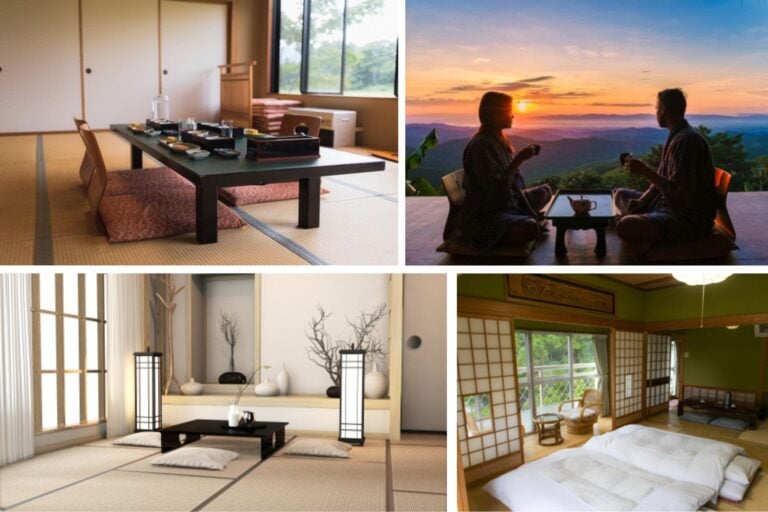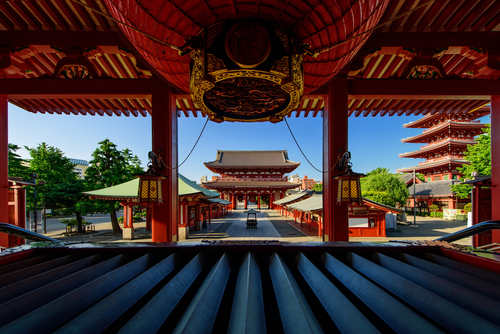Where to stay in Tokyo: long-term options
Coliving, furnished apartments, residences and traditional accommodations are some options of where to stay in Tokyo for long stays.
Tokyo, Japan’s vibrant capital, is easily one of the most captivating cities in the world. Blending deep-rooted tradition with cutting-edge modernity, it attracts millions of visitors every year from all corners of the globe. With its reputation for safety, top-notch infrastructure, and lightning-fast internet, it’s no wonder Tokyo has become a magnet for digital nomads, international students, and long-term travelers alike. If you’re up for the challenge of navigating the language barrier, spending some time living here can be an incredibly rewarding experience. That said, given its sheer size, it’s completely normal to feel a bit overwhelmed when deciding where to stay in Tokyo. But don’t worry — that’s exactly what we’re here to help with.
At Holafly, we’ve put together this guide to long-term stays in Tokyo with those planning to spend several weeks — or even months — in the city in mind. We know how important it is to find the right place to live, especially in a city made up of dozens of neighborhoods, each with its own unique vibe and personality.
We’ll walk you through a variety of accommodation options — from sleek, modern coliving spaces to charming, traditional stays — and help you get to know Tokyo’s top neighborhoods for longer visits. When choosing the best areas, we looked at things that matter: safety, access to public transport, cost of living, nearby attractions, and how well they cater to digital nomads. Our goal? To help you feel at home in Tokyo and make the most of your time here. Grab a seat and dive in — there’s plenty of useful info ahead.
Where to stay in Tokyo? Options for all types of travelers
Tokyo is a massive, diverse, and surprisingly efficient city — and the same can be said for its range of accommodation. Whether you’re a backpacker on a budget, a digital nomad, a business traveler, an international student, or someone looking to splurge, there’s something here for everyone. From luxury hotels to modest apartments and even traditional stays like ryokan or minshuku, Tokyo offers a wide variety of places to call home, no matter your travel style or budget.
Here are the most recommended alternatives for those who need a temporary home in this modern metropolis.
Colivings in Tokyo: An option for digital nomads
Coliving spaces have been growing in popularity around the world — and Tokyo is no exception. With its large community of digital nomads and remote workers, coliving has become one of the top housing options for those looking to connect with like-minded people, share experiences, and build professional networks. In fact, Tokyo ranks among the top five cities in Japan for living the digital nomad lifestyle.
So, why choose a coliving space in Tokyo? Honestly, the perks are endless. For starters, they tend to be more affordable than many traditional accommodations. You get the best of both worlds — your own private room plus access to shared spaces like kitchens, lounges, coworking areas, and even rooftops. Most coliving places offer flexible lease terms, making them perfect for both short and long stays. But what really sets them apart is the sense of community they foster and the chance to connect with people from all over the world. And as a bonus, essentials like high-speed internet and cleaning services are usually included in the price.
In short, they are ideal for solo travelers who want to network or for those who are looking for an all-in-one solution for living and working.
What is the price of coliving in Tokyo? Let’s see:
- The estimated price of a private room is around ¥80,000 and ¥130,000 ($550 to $900).
- A shared room can start at ¥50,000 ($350).
Furnished apartments
Another popular option for longer stays in Tokyo is renting a studio or a 1LDK apartment. These typically include a separate bedroom and an open-plan space that combines the living room, dining area, and kitchen. They’re usually furnished and come with a private bathroom, a kitchen, a washing machine, and often even a desk — making them a practical choice for both living and working.
There are also larger options like 2DK apartments (two bedrooms plus a dining-kitchen area) and 3K units (three bedrooms and a kitchen). These setups are better suited for bigger families or if you’re planning to share the space with a colleague or roommate.
Apartments in Tokyo can also be rented on a monthly basis, with utilities typically included in the total cost — and no need to commit to a long-term lease. You could say they offer many of the same conveniences as coliving spaces, just without the communal aspect. That’s why a furnished apartment can be a great choice for those who value privacy, a tidy environment, and having their own dedicated space to live and work.
The cost of furnished apartments depends on many factors, primarily the location and length of stay.
- The monthly estimate for a studio or 1LDK apartment is ¥100,000 to ¥180,000 ($680 to $1,200).
- For one-bedroom apartments the price starts at ¥150,000 ($1,020).
Where to stay in Tokyo? Seasonal Airbnb
Renting through platforms like Airbnb is often a convenient solution in many cities around the world, and Tokyo is no exception. The variety of options available is vast, ranging from homes with pools and bed & breakfasts to fully furnished apartments.
Many hosts in Tokyo also offer discounts for stays of 28 days or longer. This makes it a great option for finding better rates, getting a hassle-free place to stay, and booking right away.
The cost of renting through Airbnb in Tokyo is:
- Between ¥120,000 and ¥200,000 ($820 to $1,400) for studios and mini-apartments.
- From ¥200,000 ($1,400) and up for larger or centrally located spaces.
Residences for students or young professionals
Tokyo has modern residences with private rooms, shared areas, and services like cleaning and laundry. These are designed for long stays and are particularly popular among university students and interns. However, some also welcome remote workers or freelancers, as long as they meet the minimum stay requirement.
In terms of price, they are among the most affordable and common options among foreigners:
- A single room can cost between ¥60,000 and ¥90,000 ($410 to $620).
Traditional accommodations in Tokyo
In addition to Western accommodation options, in Tokyo (and throughout Japan) there are other alternatives that allow you to live a more authentic experience and feel like a local.
One of these options is the ryokan, a traditional Japanese lodging with a minimalist design, tatami floors, an ofuro-style bathtub, and a futon for sleeping. There are luxury versions with fully-equipped rooms, as well as more modest, compact ones.
One advantage of this type of accommodation is that it often includes a traditional breakfast and dinner, offering a full immersion into Japanese cuisine. However, a downside is that ryokan aren’t the most practical or budget-friendly choice for longer stays, as many don’t have workspaces or WiFi as strong as modern accommodations. That said, it can still be a great experience for a couple of days.
Another type of traditional Japanese accommodation is the minshuku. It’s similar to a Bed & Breakfast, offering a place to sleep and a shared breakfast with other guests and the hosts. Like ryokan, it’s not the best choice for long stays, but it’s a great option for a cultural immersion for a night or two.

Stay connected throughout your stay in Tokyo
A reliable internet connection is a must for any digital nomad, not a luxury. But there’s an important catch: we’re talking about Tokyo. Connecting to WiFi here, or in most Japanese cities, isn’t as easy as it might be in other parts of the world. What’s usually a given elsewhere can be quite tricky in Japan. So, if you want to keep sharing your Shibuya crossing moments with your Instagram followers, it’s best to get Holafly’s eSIM for Japan or sign up for a Holafly Connect plan.
The first option is better suited for short trips, while Holafly Connect is the perfect solution for longer stays in Tokyo. You’ll have unlimited data from the moment you arrive, with no paperwork or hassle. Plus, with any of their plans, you’ll have internet not just in Japan, but in 175 other countries as well. It’s ideal if, in addition to Tokyo, you plan to explore other Asian destinations like Seoul, Bangkok, or Bali during your trip.
Important: If you are a frequent traveler and want to stay connected without worrying about expensive roaming or looking for a Tokyo SIM card, Holafly’s subscription plans are for you. With a single eSIM, enjoy internet in more than 170 countries for a fixed price and no surprises on your bill. Travel without limits and connect easily and securely! 🚀🌍

Where to stay in Tokyo? The best neighborhoods and areas to live in for a while
Now that you know about the different types of accommodation in Tokyo, it’s time to take it to the next level: location. The Tokyo metropolitan area is massive, so when you start looking for a place to stay, it’s easy to feel a bit overwhelmed. There are over 20 districts, each showcasing the vastness and diversity of Japanese culture!
As with any big city, choosing the right neighborhood in Tokyo really depends on what you’re looking for. For example, Asakusa is perfect if you want to experience the most authentic and traditional side of the Japanese capital. In fact, it’s home to a good number of ryokan. If you don’t mind the noise, Shinjuku and Shibuya are the liveliest areas in Tokyo. However, we’d recommend staying there only if you’re a fan of nightlife, as the hustle and bustle can be intense, and the prices tend to be higher.
Since choosing the right location can make all the difference in your experience, we’ll share some of the best areas in Tokyo for digital nomads and long-term travelers.
Asakusa, the traditional district of Tokyo
Asakusa, located in the northern part of Tokyo, is the area that best preserves the essence of traditional Japan. Known as the historical district of the capital, it immerses visitors in deep-rooted traditions and typical Japanese architecture. In fact, it’s home to one of Tokyo’s oldest and most famous Buddhist temples, Sensō-ji. On the other hand, it’s also home to the Tokyo Skytree, a 600-meter tower that offers unbeatable views of the city. Another highlight, especially for food lovers, is Kappabashi Dōgugai, a street lined with shops selling all sorts of culinary products from Japanese cuisine.
Staying in Asakusa can be a wonderful experience, but keep in mind that it’s a very popular tourist area. As a result, long-term accommodation prices can be higher (though still generally lower than in Shibuya). Another downside is that, while it’s connected to the rest of the city by subway, it’s not part of the Yamanote Line, Tokyo’s main rail line that circles the city center.
What accommodation options are available for long stays in Asakusa? You can find everything from furnished apartments to small hotels with monthly rates, and even quiet coliving spaces with a local vibe.

Shimokitazawa, a good option to stay in Tokyo
Shimokitazawa, located west of Shibuya, is one of Tokyo’s most alternative and bohemian neighborhoods. With its alleys full of cafés, vintage shops, independent bookstores, and small theaters, it’s ideal for those seeking a relaxed, youthful, and creative vibe. While there aren’t any major monuments here, the neighborhood itself is incredibly charming. The graffiti-filled streets, second-hand stores, specialty cafés, and live music create a truly unique atmosphere.
An interesting detail about Shimokitazawa is that it’s one of Tokyo’s ramen hubs. Its streets are filled with small ramen spots, making it a great place to experience one of the country’s most famous dishes.
In terms of connectivity, the neighborhood is only five minutes from Shibuya on the Keio Inokashira and Odakyu lines, and perfectly connected to the rest of Tokyo.
As for accommodation options, there are several modern residences and capsule hotels with monthly rates, ideal for those needing something practical for a short stay. Digital nomads will find coliving spaces like The Share Hotels Lyuro, or places managed by HafH and Roam Tokyo, where there’s an active international community and great attention to design. You can also find small, fully furnished studio apartments, ready for you to move in.
Kōenji
Kōenji is another bohemian neighborhood in Tokyo worth considering. Located west of the city, near Shinjuku, it competes with the previous area as one of the most creative and culturally rich districts in the capital. With its second-hand vintage shops, vinyl stores, unique cafés, and more, it’s a great spot for digital nomads looking for an authentic, less touristy neighborhood with a high quality of life.
Another reason it’s well-known is the Kōenji Awa-Odori, a festival that offers a vibrant display of Japanese culture. We also appreciate its great location, just minutes from Shinjuku and well-connected to the city center.
What accommodation options are there in Kōenji? The area is perfect for renting an apartment or staying in a coliving space. For coliving, places like Borderless House and XROSS House stand out, offering affordable prices and multicultural communities in Kōenji. There’s also a wide selection of fully furnished apartments and studios starting at 20 m², ideal for stays of one or two months. Many of them even include a bike, which is a nice bonus.
Nakameguro
If the bohemian style isn’t for you, Nakameguro offers a peaceful, stylish, and aesthetically pleasing alternative for staying in Tokyo. The neighborhood is centered around the Meguro River and is famous for its cherry blossom-lined canal (Japan’s iconic tree), design boutiques, minimalist cafés, and upscale restaurants.
Nakameguro is lively year-round, but the real crowds arrive in late March and early April when the cherry blossoms are in full bloom, creating a stunning pink tunnel along the river that’s perfect for photos.
In terms of location, it is strategically located, as it has access to the Tōkyū Tōyoko and Hibiya lines, which allow you to reach Shibuya, Ebisu or Roppongi in a short time.
Accommodation options in Nakameguro range from boutique hotels (some offering long-term stays) to apartments and Airbnb-type rentals. You’ll also find boutique colivings like Cascade Nakameguro and residences from Tokyo Chapter, which are tailored to creatives, designers, and entrepreneurs. While they can be a bit pricier, the unique style and design of these places make it worthwhile.

Where to stay in Tokyo? Ueno and Yanaga
We’ll wrap up this guide to staying in Tokyo with two of the city’s most popular neighborhoods. Located in the northwest, Ueno and Yanaka are calm, local areas that offer a peaceful escape from the tourist crowds of Shibuya and Shinjuku. Plus, their prices are more affordable than in other popular parts of Tokyo. Definitely a great choice for digital nomads!
Yanaka is one of Tokyo’s most traditional neighborhoods, a survivor of bombings and earthquakes that has managed to rebuild itself. It’s known for its narrow streets, wooden houses, charming cafés, and temples at every turn. Ueno, on the other hand, stands out for its excellent connections to the rest of the city and its many museums, including the National Museum, as well as Ueno Park, which becomes a breathtaking sight in spring when the cherry blossoms are in bloom.
If you’re looking for a place to stay in Tokyo for a while, Ueno and Yanaka are excellent options. The cost of living here is more affordable, making it perfect for those on a budget. These neighborhoods offer a peaceful vibe, especially in the evenings. Despite the tranquility, there are still plenty of great restaurants where you can enjoy authentic Japanese food.
On the other hand, Ueno and Yanaga are connected by the Yamanote line, so you can reach the most popular places in Tokyo.
Frequently asked questions about where to stay in Tokyo
Most short-term rentals in Tokyo require a minimum stay of 30 days or more, especially if you’re using platforms like Airbnb, OYO Life, Unito, or Leo Palace. In coliving spaces, you can often find options for weekly or even daily stays, depending on the season.
Nakameguro and Kōenji are perfect for remote work, offering a laid-back atmosphere, cozy cafés, and solid internet. Shimokitazawa is also a great option for those who enjoy a creative environment and a neighborhood feel.
Colivings are one of the most affordable accommodation options in Tokyo. Places like XROSS House, Oakhouse, and Sakura House offer reasonable prices and flexible plans. You can even find rooms in shared apartments for less than $700 per month.
For digital platforms or colivings, all you’ll need is your passport. For traditional rentals, you may be asked for a Japanese guarantor, a valid visa, and in some cases, a residence card. This is why many digital nomads prefer options that don’t involve bureaucratic processes.





 Language
Language 


















 No results found
No results found








